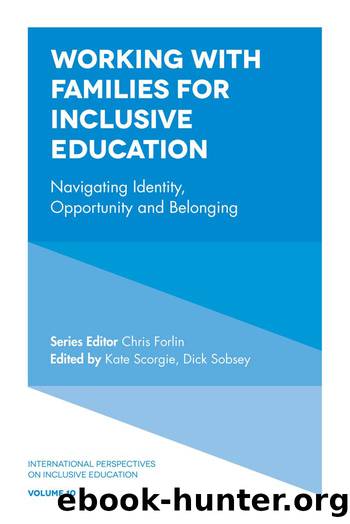Working with Families for Inclusive Education by Sobsey Dick;Scorgie Kate;Forlin Chris;

Author:Sobsey, Dick;Scorgie, Kate;Forlin, Chris;
Language: eng
Format: epub
Publisher: Emerald Publishing Limited
Published: 2017-05-11T00:00:00+00:00
CONCLUSION: IMPLEMENTING A CHANGE OF MINDSET
Since medical discourses are deeply rooted in the educational comprehension of variation between an individualâs behavior and receiving recognition, the promise of ADHD seems to remain salient and self-sustainable in everyday social practices. Therefore, a diagnostic label per se cannot be considered fundamentally undesirable outright. Yet, if the educational and pedagogical understanding of a child with difficulties in meeting the expectations of an operating environment is solely diagnosis driven and medicalized, there remains little room for the critical constructive (re-)evaluation of fundamental educational values, ones that take into account basic human needs. Therefore, one of the challenges for inclusive education is cultivating social change that promotes the growth of all students as self-accepting and self-actualizing social agents.
In this regard, the Finnish basic education system that provides a need-based three-tiered framework for support presents a potentially efficacious basis for practice for inclusive education in that, in theory at least, it is premised on homeâschool collaboration for meeting a studentâs individual needs regarding both learning (i.e., academic and social skills) and learner (i.e., socioemotional well-being) outcomes without overt categorization of ânormalâ and âother.â However, inclusive education is not about directive or material changes. It cannot be achieved only through pedagogical practices, but also must include social and discourse practices that establish an environment in which human diversity and acceptance of others and self are embraced. A potential way to eliminate some of the barriers to inclusive education brought forth in this paper is to pay serious attention to how language is used in explaining and characterizing individual traits, behavior, and performance in everyday interaction and how pedagogical means of support are experienced and perceived by the stakeholders in light of the values of inclusive education. Accordingly, in closing I have posed two guiding questions those practicing inclusion ought to ask in order to communicate and live up to the values of inclusive education in everyday interaction and practice:
What are the types of identities made available to those deemed having âspecialâ needs?
Whose and which needs are being catered to and by what means and ends?
In this regard, I further propose two guiding concepts stemming from the tradition of NVC: independency and reciprocity (Rosenberg, 2003). The former refers to skills to recognize and express oneâs own situational needs and find strategies to fulfill them while still respecting the needs of others, whereas the latter means skills to understand othersâ situational needs and adjust oneâs own behavior and practice according to those without ignoring oneâs own needs. I find these concepts complementary to those of motivational displacement and engrossment introduced by Noddings (1984, 1992), in Danforth & Naraian, 2015, pp. 76â78), by which she emphasizes putting aside personal motivations and offering oneself to the needs of another in order to foster ethic of caring. This way the responsibility of every individual stakeholder to establish a caring, accepting, and responsive inclusive education environment becomes accentuated.
To conclude, the point here has not been to provide pedagogical insights or a moral take on arrangements of inclusive education.
Download
This site does not store any files on its server. We only index and link to content provided by other sites. Please contact the content providers to delete copyright contents if any and email us, we'll remove relevant links or contents immediately.
The Art of Coaching Workbook by Elena Aguilar(51004)
Trainspotting by Irvine Welsh(21524)
Twilight of the Idols With the Antichrist and Ecce Homo by Friedrich Nietzsche(18513)
Fangirl by Rainbow Rowell(9109)
Periodization Training for Sports by Tudor Bompa(8175)
Change Your Questions, Change Your Life by Marilee Adams(7641)
This Is How You Lose Her by Junot Diaz(6804)
Asking the Right Questions: A Guide to Critical Thinking by M. Neil Browne & Stuart M. Keeley(5664)
Grit by Angela Duckworth(5526)
Red Sparrow by Jason Matthews(5392)
Paper Towns by Green John(5094)
Room 212 by Kate Stewart(5041)
Ken Follett - World without end by Ken Follett(4647)
Housekeeping by Marilynne Robinson(4349)
The Sports Rules Book by Human Kinetics(4304)
Double Down (Diary of a Wimpy Kid Book 11) by Jeff Kinney(4210)
Papillon (English) by Henri Charrière(4200)
The Motorcycle Diaries by Ernesto Che Guevara(4020)
Exercise Technique Manual for Resistance Training by National Strength & Conditioning Association(3965)
